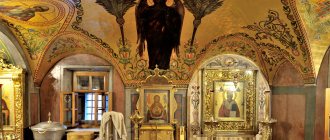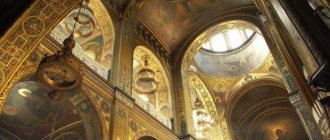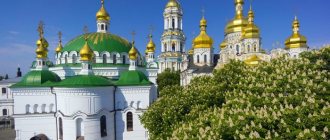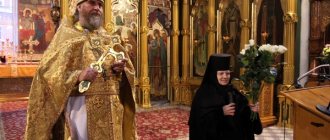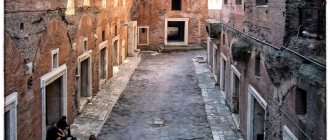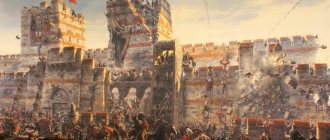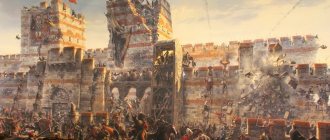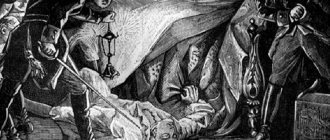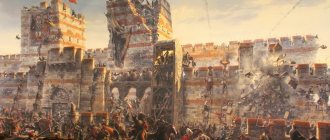KIR "STAGRAD"
Events
On March 1, 1325, Moscow became the ecclesiastical center of Rus': Prince of Moscow Ivan Kalita convinced Metropolitan Peter to move his residence from Vladimir to Moscow. Metropolitan Peter
(second half of the 13th century - 1326) - Metropolitan of Kiev and All Rus', the first of the Kyiv metropolitans who had (since 1325) a permanent residence in Moscow.
Referred to as Ratensky
.
The church-state activities of Metropolitan Peter gave grounds for his contemporaries to compare him with Saints Basil the Great, Gregory the Theologian and John Chrysostom. Peter's main feat was the fight for the unity of the Russian state and the blessing of Moscow as the collector of the Russian land.
Born in Volyn in the second half of the 13th century from pious parents Theodore and Eupraxia. According to the life of the saint, even before the birth of his son, in a dream vision, the Lord revealed to Eupraxia the gracious pre-election of her son. They say that from an early age Peter was tongue-tied and very incomprehensible, but, thanks to the miraculous appearance of a certain holy man, “Petrov’s lips were opened and his thoughts were illuminated with light.” At the age of 12, Peter entered a monastery. By that time, he had successfully studied book sciences and began to fulfill monastic obediences with particular zeal.
The future saint devoted a lot of time to careful study of the Holy Scriptures and learned icon painting. Icons painted by the monk Peter were distributed to the brethren and Christians visiting the monastery. He was the author of the first Moscow miraculous icon, called “Petrovskaya”. For his virtuous ascetic life, the abbot of the monastery ordained the monk Peter to the rank of hieromonk.
After many years of exploits in the monastery, Hieromonk Peter, having asked for the blessing of the abbot, left the monastery in search of a secluded place. He set up a cell on the Rata River and began to labor in silence. Subsequently, a monastery called Novodvorsky was formed on the site of the exploits. For the visiting monks, a temple was built in the name of the Savior. Chosen as abbot, Peter meekly instructed his spiritual children, never became angry with a guilty monk, and taught his brethren by word and example. The virtuous ascetic abbot became known far beyond the monastery. Prince Yuri Lvovich of Galitsky often came to the monastery to hear the spiritual instructions of the holy ascetic.
Once the monastery was visited by Metropolitan Maxim, who was touring the Russian land with words of teaching and edification. Receiving the hierarch's blessing, Abbot Peter brought as a gift the image of the Dormition of the Most Holy Theotokos he had painted, before which Saint Maximus, until the end of his life, prayed for the salvation of the Russian land entrusted to him by God.
In 1299, Metropolitan Maxim finally left Kyiv and settled in Vladimir on the Klyazma. Dissatisfied with this, the Grand Duke of Galicia Yuri Lvovich wanted to have his own metropolitan. For this purpose he chose Peter and sent him to Constantinople for initiation; but it was at this time that Metropolitan Maxim died (1305), and Patriarch Athanasius ordained Peter not as metropolitan of Galicia, but of all Rus'.
At the same time, the Tver prince Mikhail Yaroslavich sent his associate and like-minded abbot Gerontius to the Patriarch of Constantinople with a request to appoint him to the department of the Russian Metropolis. The Mother of God appeared to Gerontius, who was sailing the Black Sea at night during a storm, and said: “You are working in vain, you will not receive the rank of hierarch. The one who wrote Me, Father Superior Peter of Ratsk, will be elevated to the throne of the Russian Metropolis.” The words of the Mother of God were exactly fulfilled.
Patriarch Athanasius I of Constantinople and the Synod erected the Metropolis of Peter in Kyiv and All Rus', giving him the holy vestments, staff and icon brought by Gerontius. Upon his return to Rus' in 1308, Metropolitan Peter stayed in Kiev for a year, but the worries that threatened this city forced him, following the example of his predecessor, Maxim, to live in Vladimir on the Klyazma, where he moved in 1309.
At this time, there was a struggle for grand-ducal dignity between Mikhail Tverskoy and Yuri of Moscow. Metropolitan Peter took the side of the latter, as a result of which an accusation was brought against the saint before the Patriarch by Bishop Andrei of Tver. For the trial of Saint Peter, a council was convened in Pereyaslavl in 1313, which recognized Andrei’s accusation as slander.
The high priest experienced many difficulties in the first years of ruling the Russian Metropolis. There was no firm order in the Russian land, which suffered under the Tatar yoke, and Saint Peter often had to change his places of residence. During this period, the saint’s labors and concerns for the establishment of true faith and morality in the state were especially important. During his constant tours of dioceses, he tirelessly taught the people and clergy about the strict preservation of Christian piety. He called on the warring princes to be peaceful and unity.
This meek archpastor knew how to be strict. He deprived Ishmael of Sarsky of his episcopal rank, no doubt for an important crime against the Church or the Fatherland, and anathematized one dangerous heretic, Seit, whom he had accused of ungodly thinking, but who did not want to repent.
In 1313, when Uzbek, the first of the khans to convert to Islam, became khan, Saint Peter went to the Horde. He was received there with honor and released with a new label. All the previous benefits of the clergy were confirmed and a new one was added: all church people in all cases, not excluding criminal ones, were subject to the metropolitan court.
When, after the death of princes Mikhail Tverskoy and Yuri of Moscow, Prince Alexander Mikhailovich Tverskoy received from the khan a label for the great reign and entered into a fight with Ivan Danilovich (Kalita) of Moscow, Saint Peter took the side of the latter.
In 1325, Saint Peter, at the request of Grand Duke Ivan Kalita, transferred the metropolitan see from Vladimir to Moscow. This event was important for the entire Russian land. Saint Peter prophetically predicted liberation from the Tatar yoke and the future rise of Moscow as the center of all Russia.
At the request and advice of Saint Peter, Ivan Kalita founded the first stone church in the name of the Dormition of the Blessed Virgin Mary on the square in Moscow on August 4, 1326. “If you,” the saint said to the great prince, “calm my old age and build a temple of the Mother of God here, then you will be more glorious than all other princes, and your family will be magnified, my bones will remain in this city, the saints will want to dwell in it, and his hands will they will rise up on the shoulders of our enemies.” The holy metropolitan wanted to see the construction completed, but the Church of the Assumption was consecrated only on August 4, 1327, after the death of the saint.
On December 21, 1326, Saint Peter died. His body was buried in the wall of the Assumption Cathedral in a stone coffin, which he himself prepared.
- Moscow
- Rus
How the Metropolitan of Kyiv moved to Vladimir
In 1299 - 720 years ago - the head of the Russian Orthodox Church, Metropolitan Maxim, moved his residence from Kyiv to Vladimir. With this decision, Bishop Maxim forever confirmed the authority of Vladimir as the historical capital of Rus' and marked the transfer of the center of Orthodoxy and Russian statehood to the northeastern lands.
Wandering Metropolitan
In those days, the heads of the Russian Orthodox Church - the metropolitans of Kyiv - were appointed by the Patriarch of Constantinople. The fall of Constantinople and the appearance of its Russian patriarchs were still very far away.
When and where Metropolitan Maxim was born is not known for certain. But the chronicles report that he was a Greek, and in 1283 he was appointed Metropolitan of Kyiv instead of the deceased Cyril.
Things were unstable in Rus'. The princes continued internecine wars, but with the participation of the Tatar-Mongols, who established political control over most of the Russian lands. In such a situation, it was impossible for the metropolitan, as a central figure, to simply sit in his residence. So the bishop traveled around the country. Suffice it to remember that Maxim’s predecessor, Metropolitan Kirill, died while in Pereslavl-Zalessky.
Real political and military power shifted from the south to the northeast. Kyiv was no longer the same. Although, apparently, Maxim initially planned to be based there, according to custom. Immediately after arriving at his new place of duty, the Metropolitan went to negotiate in the Golden Horde with Khan Tuda-Meng, because, among other things, the head of the Russian church was an envoy of the Byzantine hierarch and the emperor.
Historical fact: the khans generally treated the Orthodox Church with respect. She was exempt from paying tribute, and this, scientists believe, explains the flourishing of monasteries at that time. By the way, in the capital of the Horde, Sarai, there was an Orthodox diocese, covering even the lands of nomads in the east.
To the city of the Virgin Mary
Having settled relations with the khan, Metropolitan Maxim returned to Kyiv. There, in 1284, he announced a gathering of Russian bishops, but the decision to leave Kyiv was already ripe. There is evidence that first the bishop went to Bryansk, and only then to Vladimir. By this time, the Horde Khan appointed the Grand Duke of Vladimir as the most important of the princes in Rus'. Although both Pereslavl and Tver laid claim to supremacy.
Apparently, it was political reasons that prompted Maxim to move. The historian Soloviev also came to this conclusion: “Maxim took a decisive, final step, which clearly testified that vital forces had completely drained from south to north, and... Kyiv lost its former importance and prosperity.”
But the chronicler thought differently. They say that the Metropolitan no longer wanted to tolerate oppression in Kyiv from the Tatar-Mongols. But who was insured against Tatar intervention in Vladimir?
The change in the 300-year-old tradition of the metropolitan residence could only be justified by a sign from above. And it happened!
To Metropolitan Maxim, as his life says, already in Vladimir “the Mother of God appeared during a dream and praised him for his decision to transfer the see to Her city.” How can one not recall the vision of Andrei Bogolyubsky, after which Vladimir began to be called the city of the Virgin Mary.
As a sign of special patronage, the Virgin Mary gave Bishop Maxim an omophorion (a handkerchief that is often depicted on icons of the Mother of God - Author's note ). Waking up, the Metropolitan found this omophorion in his hands.
Prince Andrei Alexandrovich of Vladimir, son of Nevsky, ordered a golden ark to be made for the omophorion. And it was allegedly kept in the Assumption Cathedral until the attack on Vladimir by the Tatar detachment of Talych in 1411. According to legend, then the omophorion was hidden somewhere by the sacristan of the cathedral, Patrikey, from whom the enemies never found out about the caches with relics (the film version of these events is shown in Tarkovsky’s film “Andrei Rublev” - Author’s note ).
In memory of the miraculous vision of the Metropolitan, an icon was painted - the Mother of God of Maximovskaya. She is considered miraculous.
Maxim's deeds and words
So in 1299, Metropolitan Maxim moved “with the choir and with all his life” to Vladimir. He headed the Vladimir diocese himself, and transferred the local bishop Simon to Rostov the Great. From that time until the 18th century, the Vladimir diocese was part of the Metropolitan, then the Patriarchal, and even later the Synodal region.
Of the most important deeds of Metropolitan Maxim, contemporaries especially remembered that in 1300 he personally elevated the highly revered Saint Theoktistos to the rank of archbishop in Novgorod.
It was Bishop Maxim who created the current system of fasts for the Orthodox. In addition to Great Lent, he established the Apostolic (Petrov), Assumption and Nativity fasts and approved the conditions for observing fast days on Wednesdays and Fridays.
Maxim especially called on his flock to have church and married marriages, which, apparently, were neglected by many in the era of upheaval. “I am also writing that you, my children, should accept wives from the Holy Catholic and Apostolic Church, wives for the salvation of mankind. If you keep them in fornication, without marriage, what help is there for you? No, beg and compel them, let them, whether old or young, get married in church,” the Metropolitan insisted in his essay “Rules on Fasting and Preservation of Marriage.”
In 1301, another long and significant trip took place, but already far to the south - Metropolitan Maxim visited the Patriarchal Council in Constantinople.
But these are all religious matters. And there was also the participation of Bishop Maxim in worldly affairs. The Metropolitan either did not catch the emerging Moscow trend of Russian statehood, or for some reason did not agree with the rise of Moscow. And the tough struggle for the khan's label for the great reign of Vladimir was then waged by Moscow Prince Yuri Danilovich and Tver Prince Mikhail Yaroslavich (later canonized). The Metropolitan supported the Tver applicant and himself placed Mikhail Yaroslavich on the grand-ducal throne in Vladimir in 1304.
In 1305, Metropolitan Maxim of Kiev and Vladimir died and was buried with honors in the Assumption Cathedral. Later he was canonized as a saint and entered the Cathedral of Vladimir Saints.
After the death of Maxim, the Vladimir period of the metropolitan see in Vladimir did not last long. The next metropolitan was the Volyn abbot Peter. The new metropolitan, although not immediately, supported the Muscovites. After the victory over the Moscow-Tatar army, Mikhail Tverskoy was summoned to the Horde and killed there in 1318. And in 1325, Metropolitan Peter moved his residence to Moscow “at the request” of Ivan Kalita.
…For twenty-six years the metropolitans of the Russian Church lived in Vladimir and ruled from here. Maxim, with his move from Kyiv, completed what Andrei Bogolyubsky began in the 12th century. The center of Russian statehood and Orthodoxy was consolidated in the northeast. Centuries have passed - everything has changed, but the significant event of more than 700 years ago still resonates today: the consequences of the departure of the Kyiv Metropolitan to Vladimir became an argument in church disputes between Moscow, Kiev and the Patriarch of Constantinople over the subordination of the Orthodox Church in Ukraine.
This day in the history of Vladimir: January 3
January 3, 1327 (December 21, 1326 old style) – Metropolitan Peter died, having moved the metropolitan residence from Vladimir to Moscow. Therefore, today the church celebrates the day of remembrance of St. Peter, Metropolitan of Moscow.
In fact, Peter received the rank of Metropolitan of Kyiv and All Rus' from the Patriarch of Constantinople. But by that time, his predecessor, Metropolitan Maxim of Kiev, had already moved his residence from restless Kyiv to the capital city of Vladimir.
The new Metropolitan Peter, having spent about a year in Kyiv, also went to live in Vladimir in 1309. That is, he actually became the Metropolitan of Vladimir and All Rus'. Here he soon became famous for his ability to establish contacts with the Horde. Just at that time, the Mongol-Tatars, led by Khan Uzbek, switched from paganism to Islam. And Metropolitan Peter in 1313 traveled from Vladimir to the Horde, was received there with respect and successfully confirmed the immunity and benefits of the Orthodox clergy.
Meanwhile, the struggle for the khan's label for the great reign of Vladimir flared up between Tver and Moscow. Peter supported the Moscow prince Ivan Kalita. And “at his request” in 1325 he transferred the metropolitan see from Vladimir to Moscow.
The Moscow princes have since received a powerful ideological resource for their power ambitions, and Vladimir has lost such an important capital feature as the residence of the metropolitan.
Metropolitan Peter still managed to convince Prince Ivan Kalita to build the Assumption Cathedral in Moscow (as in Vladimir!), and soon died. Already 13 years later he was canonized as St. Peter, Metropolitan of Moscow.
On January 3, 1915, composer Sergei Taneyev completed the score of his “swan song”, his last major work - the cantata “After the Reading of the Psalm” (op. 36).
Sergei Taneyev worked on a cantata based on the verses of Alexei Khomyakov, which became an artistic interpretation of the 49th Psalm of David, from 1912 to 1914. He dedicated the work to his mother, Varvara Pavlovna, from whom he heard Khomyakov’s poems as a child.
In March 1915, the cantata premiered - twice in Moscow and twice in St. Petersburg, with unprecedented success. And in June of the same year, Taneyev died.
On April 18, 2013, Sergei Taneyev’s cantata “After the Reading of the Psalm” was presented on the stage of the Great Hall of the Moscow Conservatory by the Russian National Orchestra under the direction of Mikhail Pletnev, soloists and the Moscow Chamber Choir under the direction of Vladimir Minin.
The cantata is regularly published on discs in various versions; dissertations are defended on its basis
Musicologists call “After the Reading of the Psalm” the last great work of Russian musical classics, the testament of an outstanding composer-philosopher.
The famous music critic Boris Asafiev wrote about the cantata of the great Taneyev: “... Behind every bend of musical thought there is the creative will and inspired feeling of the composer.” And on my own behalf, I always want to add to these delights of connoisseurs - a composer born in Vladimir.
For what reasons did Metropolitan Maxim decide to leave Kyiv?
At that time, Rus' was in a state of civil strife, in which the Mongol invaders also participated. They controlled the policies of the Russian princes, so the metropolitan had to visit different regions and reconcile the principalities.
The Golden Horde headquarters respected the Orthodox Church, which did not pay tribute to the khan. During that period, monasteries were actively built throughout Rus'.
For political reasons, Maxim decided to move the metropolitan see from Kyiv to another city. The works of the historian Solovyov say that with such a decisive step Maxim made it clear that the South had ceased to dominate Rus', and the northern principalities strengthened their political role, which they had taken away from Kyiv. True, one of the chronicles says that the main reason for Maxim’s move was the destruction of the city by the Mongol army under the command of Khan Tokhta.
Later mentions of Saint Peter
Metropolitan Peter is often mentioned in Russian chronicles. All important government decisions were made after prayer at his tomb. In 1472, the Assumption Cathedral was rebuilt. This was accompanied by the discovery of the incorruptible relics of St. Peter. They were consecrated and transferred to the new Assumption Cathedral.
Queen Anastasia, whose husband was Ivan the Terrible, saw the appearance of Metropolitan Peter on August 4. This day became the holiday of the manifestation of the relics of the saint, who in the appearance forbade the opening of his coffin for all time. They put a seal on it and established a holiday.
Choose an answer
Moscow period 1325 - 1461
Metropolitan Theognostos 1328-1353
Saints Photius, Theognostus and Cyprian
Metropolitan Theognostos was a Greek by birth, successor of St. Metropolitan Peter. Having received initiation in Constantinople in 1328, he was sent to Russia by the Patriarch. First he visited Kyiv, where his official primate cathedra was located, then Vladimir, where his cathedra as a diocesan bishop was located, and, finally, Moscow. Theognostus settled in Moscow. In 1328, Moscow Prince. Ivan Danilovich, nicknamed Kalita (money bag), received a label from the khan for the great reign. In 1329, Theognost visited Novgorod and from there declared an anathema to the Pskovites, who had received the disgraced Prince of Tver Alexander Mikhailovich. Alexander had to leave Pskov and went to Lithuania. Soon, however, he returned and began to reign in Pskov. Pskov's old desire to gain church independence intensified: the Pskovites chose a certain Arseny as their bishop and sent him to be consecrated to the metropolitan, but Theognost refused them this. Theognostus managed to close the Lithuanian and Galician metropolises that were open, but the latter in 1337 - 1338. was rediscovered and existed until 1347. The Metropolitan received the blessing in 1339 to glorify Metropolitan Peter. Kartashev emphasizes: “Theognost is remarkable in the history of Moscow in that, being a stranger (by origin) to Moscow, he contributed to its successes all his life as a Russian patriot.” Metropolitan Peter was canonized. The Novgorod Chronicle in 1341 reports: “Metropolitan Theognost of the Grechins arrived in Novgorod with many people, but it was hard for the Lady and the monastery to provide food and gifts.” Like his predecessors, Theognostus undertook travels throughout his metropolis. Theognost traveled to the Horde twice. On his second trip (1342) he encountered great trouble there. Someone told Khan Janibek that the metropolitan collects large incomes from the clergy and that he has a lot of money. Khan demanded payment from him from all the clergy. Theognost endured all sorts of torture in the Horde, gave away up to 600 rubles to various strong people and insisted that the khan confirm for the church all its previous benefits with a new label. Theognostus built 4 stone churches: 1. John Climacus, now this is the bell tower of Ivan the Great. 2. Temple in honor of St. Peter's, as a chapel to the Assumption Cathedral. 3. Church of the Holy Savior on Bor. 4. Temple of the Archangel Michael (later the Archangel Cathedral will be built on this site). All 4 churches are Kremlin churches.
Church of St. John the Climacus with the bell tower of Ivan the Great
Cathedral of the Savior on Bor
Cathedral of the Archangel
After a long illness, he died on March 11, 1353 from a pestilence (epidemic), probably the plague, which was called the “Black Death.”
He was buried in the Assumption Cathedral of the Moscow Kremlin. In 1471, his relics were found incorrupt, but they rest in secret. The memory of Saint Theognostos is celebrated on March 14 (according to the Julian calendar). Theognostus agreed to the glorification of Metropolitan. Petra. This is very surprising. The Greeks were not favorable to the glorification of Russian saints. Metropolitans of Kiev: Michael of Kiev, Leon, John I, Theopemptus, Cyril I, Hilarion of Kiev, Ephraim, George, John II, John III, Nicholas, Nicephorus I, Nikita, Michael II, Clement Smolyatich, Constantine I, Theodore, Constantine II, John IV, Michael III, Nikephoros II, Matthew, Cyril I (II), Joseph, Cyril III. Vladimir period: Maxim, Peter. Moscow period:
Theognostus, Alexy (1354-1378), Michael (Mityai), Pimen, Dionysius (1383 - 1385), Cyprian (1389-1407), Photius, Gerasim, Isidore of Kiev, Jonah
Metropolitans of Moscow: Theodosius, Philip I, Gerontius , Zosima, Simon, Varlaam, Daniel, Joseph, Macarius, Athanasius, Philip II (Kolychev), Kirill, Anthony, Dionysius, Job. Patriarchs of All Russia: Saint JOB, IGNATIUS, Hieromartyr HERMOGENES, PHILARET, JOASAPH I, JOSEPH, NIKON, JOASAPH II, PITIRIM, JOAKIM, ADRIAN, Metropolitan of Yaroslavl STEPHAN, Holy Synod, Saint TIKHON, SERGIUS, ALEXIY I, PIMENI, ALEXIY II, KIRILL.
HISTORY of the Vladimir region.
Copyright © 2015 Unconditional love
Creation of the metropolitan see in Vladimir
In 1299, Maxim first settled in Bryansk, and then founded the metropolitan see in Vladimir. At the same time, the Golden Horde gave priority to the Prince of Vladimir over other Russian principalities. The local bishop Simeon began to rule in Rostov. Following Maxim, the entire metropolitan clergy moved to a new location, and Kyiv remained under the control of the vicar of the head of the Russian Orthodox Church. Until the 18th century, the Vladimir diocese had Metropolitan status. Later it became the Patriarchate, and then the Synodal region.
The appearance of the Mother of God to Maxim in a dream and the holy gift from the Virgin Mary
According to the life of Metropolitan Maxim, in Vladimir he had a prophetic dream about the Mother of God, who praised the head of the Russian Orthodox Church for moving to Her city. The Mother of God expressed special patronage to the metropolitan, giving him an omophorion (a scarf depicted in iconographic images of the Virgin Mary). When Maxim woke up, he saw that his hands were holding the same omophorion from the Virgin Mary.
By order of Prince Andrei Alexandrovich of Vladimir, the omophorion began to be stored in a golden ark specially made for it. The shrine was moved to the Assumption Cathedral, where it remained until 1411, when Talych and his detachment plundered the church. There is a legend that the cathedral keymaster Patrikey managed to hide the shrine in a hiding place, which the Mongol-Tatars did not know about.
How Moscow became the ecclesiastical capital of Russia. In pictures
Estimated reading time: less than a minute.
From the time of the Baptism of Rus' until the end of the 13th century, the residence of the heads of the Russian Church was located almost all the time in Kyiv. However, after the invasion of Batu in 1240, the great city was abandoned for a long time. Metropolitan Maxim chose Vladimir-on-Klyazma as his new residence. Unfortunately, this formerly rich metropolitan center suffered greatly from the Horde. At the beginning of the 14th century, Metropolitan Peter, after some hesitation, again moved his residence - this time to Moscow. The memory of Saint Peter is celebrated on September 6.
Metropolitan Peter was on good terms with the Moscow prince Ivan Kalita. The saint died in 1325 and was buried in the Assumption Cathedral of the Moscow Kremlin, which was under construction. He chose the burial place for himself. This event became a symbolic transfer of the metropolitan residence from Vladimir to Moscow.
During the childhood years of Moscow Prince Dmitry Donskoy, Metropolitan Alexy headed the boyar government, and his voice was decisive in sovereign affairs.
In the middle of the 15th century, the Moscow Metropolis acquired “autocephaly,” that is, independence from the Patriarch of Constantinople. Metropolitan Isidore, a supporter of union with Catholicism, was forced to flee Moscow. In his place, the council of Russian bishops elected Jonah as metropolitan.
In the fate of the Moscow Metropolis, it often happened that the powerful sovereign put pressure on it, trying to limit the spiritual independence of the Church. But it was much worse when the ruler, due to his weakness, could not control the autocratic aristocracy. She interfered in the affairs of the Church with cruelty and self-interest. Thus, in the childhood years of Ivan IV, the nobility overthrew some metropolitans and installed others, regardless of the greatness of their clergy.
In the middle of the 16th century, Metropolitan Macarius, a great spiritual writer, led our Church through great educational works. An all-Russian pantheon of saints, a collection of legal and moral institutions “Stoglav” appeared, and large-scale church chronicles were kept.
Moscow metropolitans resisted the bloody experiment of the oprichnina. Metropolitan Athanasius renounced his high rank, citing poor health, and Metropolitan Philip denounced the tsar's unrighteousness publicly and openly. He was not afraid of the threats of Ivan IV, the agony of imprisonment and the execution of relatives. Later, he was strangled in the Tver Otroch Monastery by the guardsman Malyuta Skuratov. The Russian Church glorified Philip as a saint.
In 1589, by agreement between the Moscow ruler Tsar Fyodor Ivanovich, the Moscow Metropolis and Patriarch Jeremiah II of Constantinople, a patriarchate was established in Moscow. Jeremiah appointed Job as the first Patriarch of Moscow. Later, other Greek patriarchs approved this decision.
Drawings by Elena Popovskaya.
Consequences of the transfer
This event was significant for the Moscow prince. It repeatedly strengthened the position of secular power, equating it with spiritual power. Fiognost was entirely on the side of Ivan Kalita, helping the latter in annexing neighboring lands to the Moscow principality. For example, Fiognostus widely used the privilege of the popes to impose and lift curses not only on individuals, but even on cities and lands. So he placed a curse on the residents of Pskov and its environs because they refused to hand over the Tver prince to Khan Ulugbek, thereby provoking the owner of the Golden Horde to new raids and destruction. The anathema gave a tangible result - the Prince of Tver Alexander Mikhailovich left Pskov and went to the Principality of Lithuania. After this, the curse was lifted.
